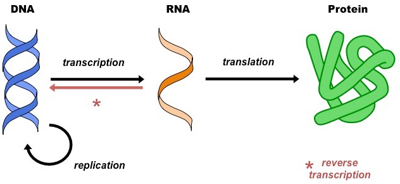Intoduction to Genetics
Once Upon a Time … Life: The Cell

Source: Abandoned Tube, https://youtu.be/V1hAgh77v9U?si=2GTLDG30aJmjM4t8&t=374
Here you can a brief introduction into various topics involved in the challenge.

Image Source: http://personal.cityu.edu.hk/liangdai/post/central-dogma-translation-transcription/
The Central Dogma
In 1958, Francis Crick proposed the Central Dogma of molecular biology. This principle outlines the flow of genetic information though a biological system. Information stored as DNA, is transcribed into RNA which is then translated into proteins.
DNA Replication
Before cells divide, they must replicate their DNA to ensure that each new cell receives a complete set of genetic information. DNA replication is a highly accurate process that involves unwinding the DNA molecule and synthesizing new strands complementary to the original strands.
Transcription
Transcription is the process by which the genetic information encoded in DNA is copied into a complementary RNA molecule. This process takes place in the cell nucleus and is carried out by an enzyme called RNA polymerase. The resulting RNA molecule, known as messenger RNA (mRNA), serves as a template for protein synthesis.
Translation
Translation is the process by which the genetic information carried by mRNA is decoded to produce a specific sequence of amino acids, which are the building blocks of proteins. This process takes place in the ribosomes, cellular structures composed of RNA and protein. Transfer RNA (tRNA) molecules bind to specific amino acids and deliver them to the ribosome, where they are joined together to form a polypeptide chain, or protein.
Gene
Gene is a segment of DNA that contains the instructions for building and functioning of an organism. Genes are the basic units of heredity, passed down from parents to offspring, and they play a crucial role in determining an organism’s traits and characteristics.
Genes typically consist of two main sections: coding regions and non-coding regions. Coding regions, also known as exons, contain the instructions for building proteins. These regions are transcribed into messenger RNA (mRNA) which serves as a template for protein synthesis, with each set of three nucleotides (codon) coding for a specific amino acid, the building block for proteins.
Non-coding regions include introns, which are intervening sequences within genes that are spliced out during mRNA processing, and regulatory regions, which play crucial roles in controlling gene expression. Regulatory regions contain sequences that serve as binding sites for transcription factors, proteins that regulate the initiation of transcription. By binding to specific DNA sequences, transcription factors can modulate the expression of nearby genes, influencing their activity levels.
Gene Expression
Gene expression refers to the process by which the information stored in a gene is used to create a functional product, such as a protein. This process involves transcription of DNA into RNA and translation of RNA into protein. Gene expression includes a series of tightly regulated steps that control when, where, and how much of a particular gene’s product (usually a protein) is produced. This regulation is crucial for maintaining the proper functioning of cells and tissues in an organism. Factors such as environmental cues, developmental stage, and cell type can influence gene expression patterns.
Disruptions in gene expression can lead to abnormal levels or functions of proteins, which can contribute to disease development. For example, mutations in regulatory regions of genes can alter the timing or amount of gene expression, leading to overproduction or underproduction of a particular protein. Similarly, mutations within the coding regions of genes can result in defective proteins or proteins with altered functions, which can disrupt normal cellular processes and contribute to disease phenotypes.
A mutation in the coding part of a gene can lead to various consequences, ranging from premature truncation of the protein production to frameshifting the coding sequence and resulting in a nonfunctional or severely altered protein.